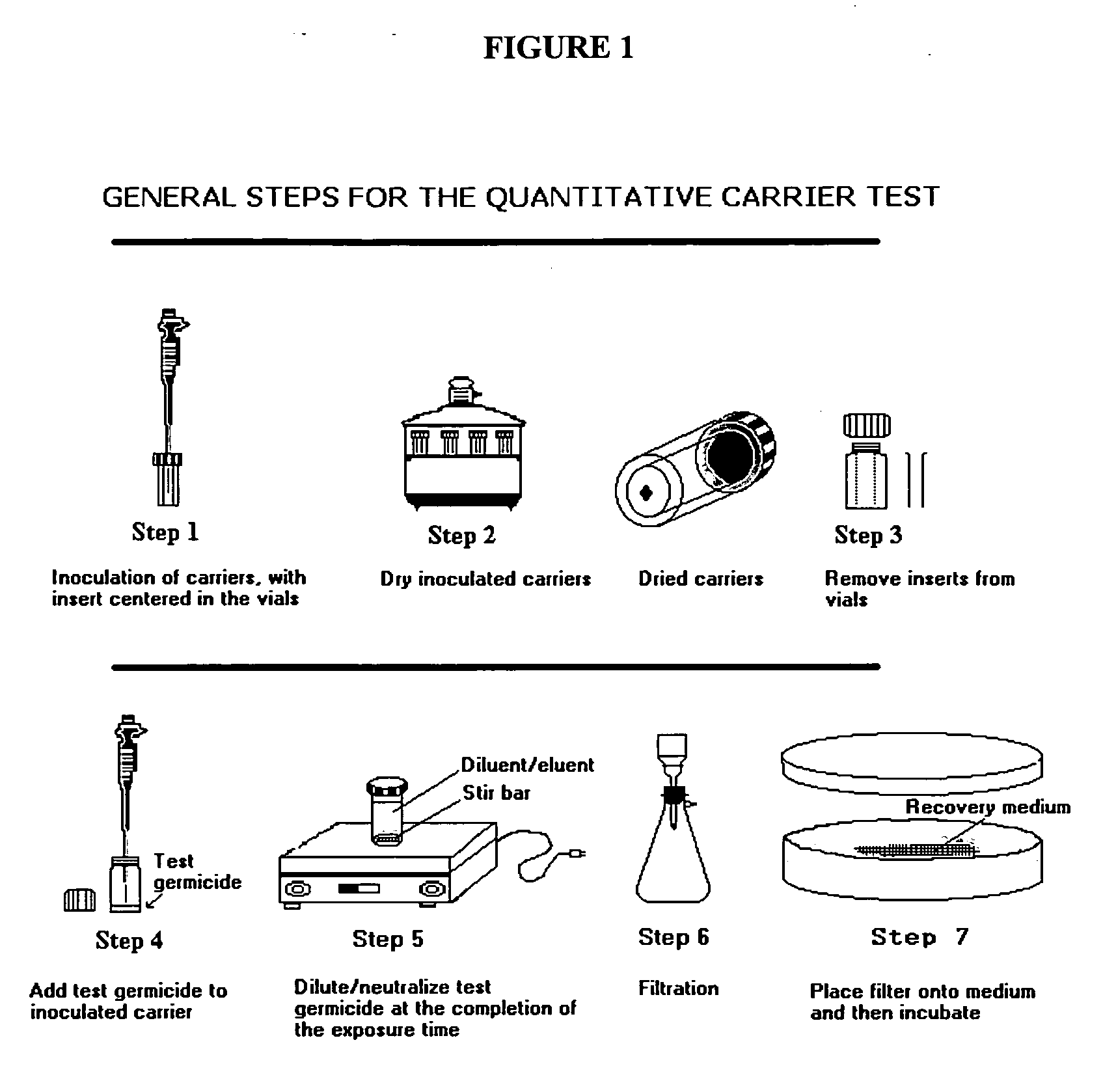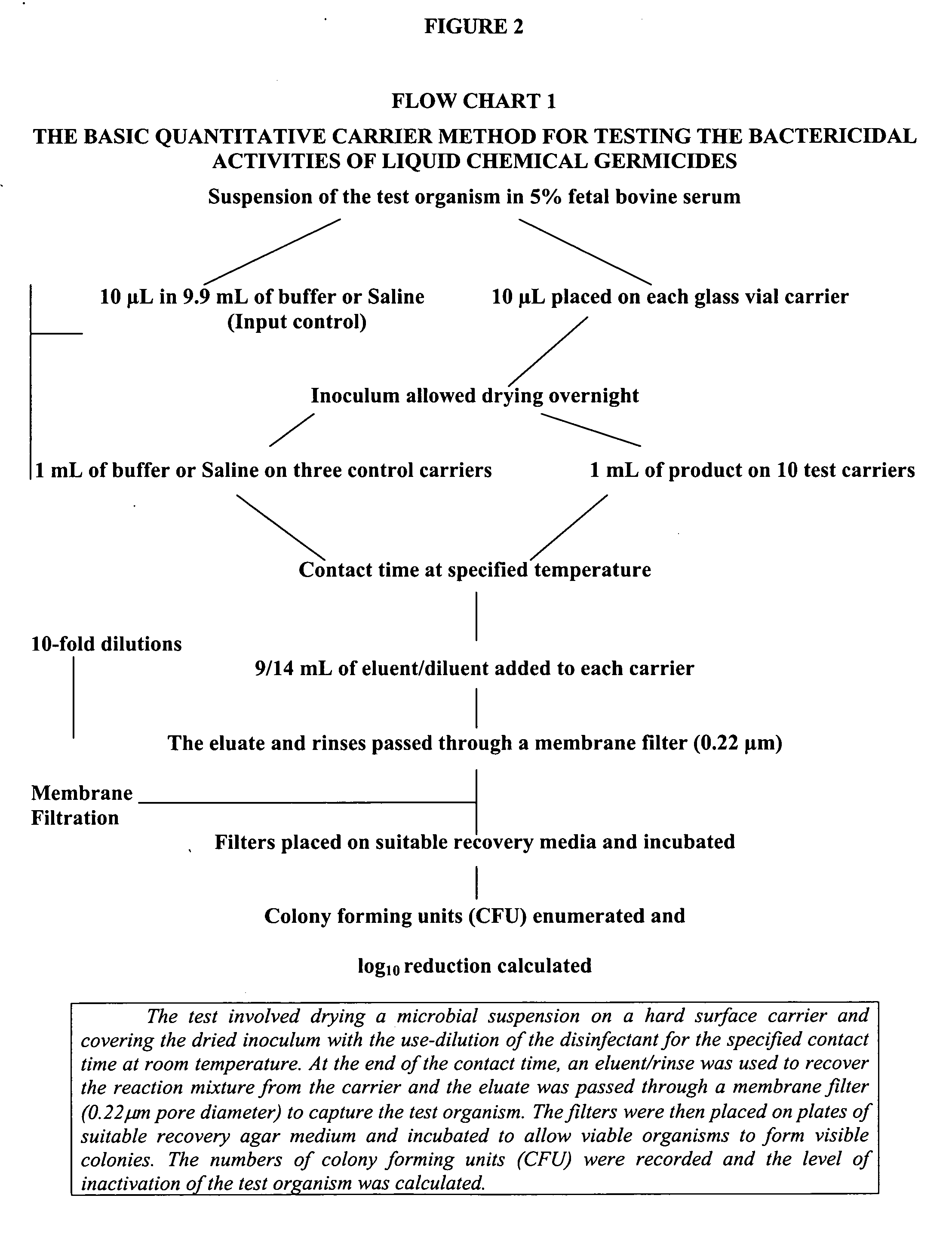Hydrogen peroxide disinfectant containing a cyclic carboxylic acid and/or aromatic alcohol
a technology of hydrogen peroxide and aromatic alcohol, which is applied in the direction of salicyclic acid active ingredients, heterocyclic compound active ingredients, biocide, etc., can solve the problems of serious occupational safety and environmental disposal hazards, low efficacy of liquid chemical disinfectants, and high cost. , to achieve the effect of high efficacy
- Summary
- Abstract
- Description
- Claims
- Application Information
AI Technical Summary
Benefits of technology
Problems solved by technology
Method used
Image
Examples
example i
Composition I was tested for bactericidal, virucidal, fungicidal and mycobactericidal activity using a quantitative carrier test method. Its effectiveness as a sanitizer was tested using a suspension test method. These methods will be described further below.
Materials and Methods
Carriers
The inside bottom surface of glass vials (Galaxy Co., Newfield, N.J.) was used as the carrier for all tests except those against the virus.
Soil Load
For inoculation of the carriers, all test organisms were first suspended in bovine serum (Gibco BRL Life Technologies Cat. No. 16000-044, NY, USA), at a final concentration of 5% w / w.
Neutralizer, Microbial Diluent and Filter Rinse
Letheen Broth (with 0.1% w / w sodium thiosulfate pentahydrate) was used as the neutralizer and to rinse the membrane filters and the filter holder unit. A 1% w / w sodium thiosulfate pentahydrate in LB was used as neutralizer for testing with Pseudomonas aeruginosa. Normal saline was used to make dilutions of the bact...
example ii
This example further illustrates the mycobactericidal activity of Composition I, as well as the synergy of the 2-furan carboxylic acid and hydrogen peroxide in the mixture. The methodology employed for the evaluation of mycobactericidal efficacy is the quantitative carrier method described above (ASTM Standard E2111). Currently, the passing standard in Canada for noncritical disinfection is a greater than 4-log10 reduction in viable numbers of microorganisms, while for semicritical and critical applications it is greater than 6-log10.
The results for Composition I and alternative compositions A, B, and C are tabled below.
TABLE IITEST SAMPLELog10 reductionComposition I5.30 in 5 min.(A) 0.50% 2-furoic acid in DI water at a pH of 1.8<2.0 in 5 min.(B) 0.50% Hydrogen peroxide in DI water at a pH of 1.8<1.0 in 5 min.(C) Composition I without 2-furoic acid<1.0 in 5 min.
DI water = deionized water
2-furoic acid = 2-furan carboxylic acid
It is seen from the above results t...
example iii
In this example, the sporicidal and mycobactericidal properties of Composition II are illustrated. Once again, the quantitative carrier method was used. However, the experiments were run at a temperature of 54° C. to simulate use of the disinfectant in an endoscope processing machine. The surrogate organism for measuring sporicidal efficacy was Bacillus subtilis. The surrogate organism for measuring mycobactericidal efficacy was mycobacterium terrae. Once more, relevant comparative examples (Compositions A, B, and C) are included which describe the synergy between the 2-furoic acid and other components of the solution. The contact time was 15 minutes.
TABLE IIILog10Log10reductionreduction(bacillus(mycobacteriumTEST SAMPLEsubtilis)terrae)Composition II6.047.00(A) Composition II with 0.50% active4.60 H2O2 and no 2-furoic acid(B) Composition II with no 2-furoic acid4.90(C) Composition II with 0.75% 2-furoic<<4.0 acid and no H202
2-furoic acid = 2-furan carboxylic acid
It ...
PUM
| Property | Measurement | Unit |
|---|---|---|
| temperature | aaaaa | aaaaa |
| vapor pressure | aaaaa | aaaaa |
| time | aaaaa | aaaaa |
Abstract
Description
Claims
Application Information
 Login to View More
Login to View More - R&D
- Intellectual Property
- Life Sciences
- Materials
- Tech Scout
- Unparalleled Data Quality
- Higher Quality Content
- 60% Fewer Hallucinations
Browse by: Latest US Patents, China's latest patents, Technical Efficacy Thesaurus, Application Domain, Technology Topic, Popular Technical Reports.
© 2025 PatSnap. All rights reserved.Legal|Privacy policy|Modern Slavery Act Transparency Statement|Sitemap|About US| Contact US: help@patsnap.com


